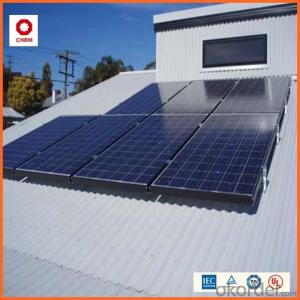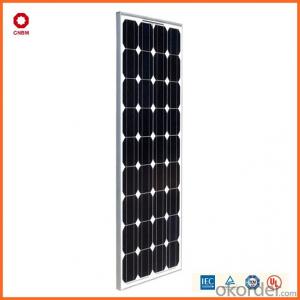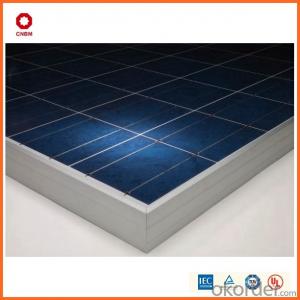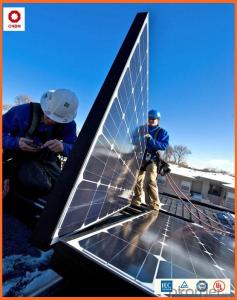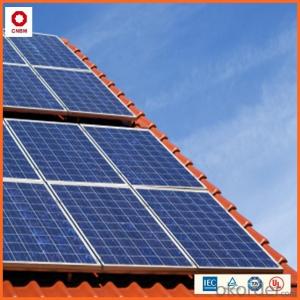125w Small Solar Panels in Stock China Manufacturer
- Loading Port:
- China main port
- Payment Terms:
- TT OR LC
- Min Order Qty:
- 1 watt
- Supply Capability:
- 10000000 watt/month
OKorder Service Pledge
OKorder Financial Service
You Might Also Like
Item specifice
Product Description:
Hot Sale !!! Quality and Safety of Small Poly Solar Panel 5w~150w
1. Rigorous quality control meets the highest international standards.
2. High-transmissivity low-iron tempered glass, strong aluminium frame.
3. Using UV-resistant silicon.
4. IS09001/14001/CE/TUV/UL
Warranties of Small Poly Solar Panel 35~85w
1. 10 years limited product warranty
2. 15 years at 90% of the minimal rated power output
3. 25 years at 80% of the minimal rated power output
Specification
Characteristics of Poly solar panels CNBM (245-320W) | |||||
Max Power Voltage Vmp(V) | 30.3 | 30.8 | 31.1 | 31.4 | 31.85 |
Max Power Current Imp(A) | 7.60 | 7.64 | 7.73 | 7.81 | 7.85 |
Open Circuit Voltage Voc(V) | 36.1 | 36.6 | 37 | 37.3 | 37.68 |
Short Circuit Current Isc(A) | 8.50 | 8.55 | 8.65 | 8.75 | 8.85 |
Max Power Pm(W) | 230W | 235W | 240W | 245W | 250W |
Temperature Coefficient of Cells Poly solar panels CNBM (245-320W) | |
NOCT | 45± 2 |
Temperature Coeffucients of Isc | 0.0492 |
Temperature Coeffucients of Voc | -0.3374 |
Temperature Coeffucients of Voc | -0.4677 |
Mechanical Data of Poly solar panels CNBM (245-320W) | |
Dimension | 1638 × 982 × 40 mm |
Weight | 19.5 kg |
No. of Cells and Connections | 60 (6 ×10) |
Tolerance | 0 ~ + 5 W |
Cell | Monocrystalline Cell 156 × 156 mm |
Packing | 624 Pcs/40ft(H) Container |
Limits of Poly solar panels CNBM (245-320W) | |
Operating Temperature | -40 to +85 |
Storage Temperature | -40 to +85 |
Max System Voltage | 1000VDC(IEC) / 600VDC(UL) |
Features of our products:
• High conversion efficiency mono/poly-crystalline amorphous silicon solar cells
• Modules incorporate high performance bypass diodes to minimize the power drop caused by shading
• High transmittance, low-iron tempered glass
• High performance EVA encapsulant to prevent destroying and water.
• AI frame: without screw, corner connection. 8 holes on the frame can be installed easily
• Good performance of preventing from atrocious weather such as wind and hails
• Certifications: CE IEC TUV VDE UL, Class I
• 10 years 90% power output warranty

Shipping of Small Poly Solar Panel 35~85w
By Sea | Delivery from Shanghai or Ningbo seaport |
By Air | Departure from Shanghai Pudong Airport |
By Express | Post by DHL, EMS, UPS, TNT. |
Features of our products:
• High conversion efficiency mono/poly-crystalline amorphous silicon solar cells
• Modules incorporate high performance bypass diodes to minimize the power drop caused by shading
• High transmittance, low-iron tempered glass
• High performance EVA encapsulant to prevent destroying and water.
• AI frame: without screw, corner connection. 8 holes on the frame can be installed easily
• Good performance of preventing from atrocious weather such as wind and hails
• Certifications: CE IEC TUV VDE UL, Class I
• 10 years 90% power output warranty
As a professional Solar Panel manufacturer and Supplier in China, we have our customers come around the whole world and our specialization has got a worldwide recognition. Meanwhile, with our superior quality, competitive price, prompt and excellent service, As main role in trade section of CNBM Group, CNBM International Corporation supplies products including Monocrystalline Solar Panel, Polycrystalline Solar Panel ( multicrystalline silicon Solar Panel) have received and enjoyed famous reputation in many countries and regions in the world.
- Q:Can solar energy systems be used in areas with limited access to healthcare?
- Yes, solar energy systems can certainly be used in areas with limited access to healthcare. Solar energy can power medical equipment, refrigeration systems for vaccines and medicines, lighting in healthcare facilities, and even provide electricity for telemedicine services. Implementing solar energy systems in such areas can help overcome the lack of reliable electricity supply, thereby improving healthcare access and delivery.
- Q:Can a solar energy system be installed in a remote location without access to the electrical grid?
- Yes, a solar energy system can be installed in a remote location without access to the electrical grid. Solar energy systems consist of solar panels, batteries, and inverters, which can generate and store electricity from the sun's energy. This self-contained system can provide power to remote locations, allowing them to operate independently of the electrical grid.
- Q:Are there any limitations to the lifespan of solar energy systems?
- Yes, there are limitations to the lifespan of solar energy systems. While solar panels have an average lifespan of 25 to 30 years, their efficiency gradually decreases over time. Additionally, other components such as inverters may need to be replaced after 10 to 15 years. Regular maintenance, including cleaning and repairs, is also necessary to ensure optimal performance. However, advancements in technology and regular upgrades can extend the lifespan of solar energy systems.
- Q:How does a PV system convert sunlight into electricity?
- A PV system, also known as a solar panel system, converts sunlight into electricity through the use of photovoltaic cells. These cells are made of semiconducting materials, typically silicon, which have the ability to convert sunlight directly into electricity. When sunlight hits the surface of the PV cells, it excites the electrons within the material, causing them to flow, creating an electric current. This current is then captured and harnessed by the system, allowing it to be used as electricity for various purposes.
- Q:How do solar energy systems affect the reliability of electricity supply?
- Solar energy systems can enhance the reliability of electricity supply by diversifying the energy sources and reducing dependence on traditional power grids. With solar panels generating electricity directly from sunlight, these systems can provide a stable and consistent power supply, especially during daylight hours. Additionally, when integrated with battery storage, solar energy systems can store excess energy for use during nighttime or periods of low sunlight, further improving reliability.
- Q:Can solar energy systems be used in space exploration?
- Yes, solar energy systems can be used in space exploration. In fact, solar panels are commonly used in spacecraft to generate electricity from the Sun's energy. These panels capture sunlight and convert it into electrical power, providing a reliable and sustainable source of energy for various applications in space missions. Solar energy systems are crucial for powering satellites, rovers, and even future manned missions, as they can operate efficiently and indefinitely in the space environment.
- Q:Can solar energy systems be used in powering religious institutions like churches or temples?
- Certainly, churches or temples can utilize solar energy systems to power their operations. These buildings are particularly suitable for solar power due to their spacious roofs that can accommodate solar panels. By installing these systems, religious institutions can significantly decrease their electricity expenses, save money, and become more sustainable. Sunlight is converted into usable energy by solar panels, which can then be employed to fulfill the religious institution's lighting, heating, cooling, and other electrical requirements. Recent advancements in solar technology have made it possible to store surplus energy in batteries, ensuring uninterrupted power even on cloudy days or during the night. The usage of solar energy not only reduces the operational costs of religious institutions but also aids in reducing their carbon footprint. By minimizing reliance on fossil fuels, solar power systems contribute to mitigating climate change and advocating for environmental stewardship. This resonates with the core principles of numerous religious organizations that emphasize the significance of environmental sustainability and responsible Earth stewardship. Moreover, solar energy systems can serve as visible demonstrations of the religious institution's dedication to sustainable practices, inspiring both members and the wider community to adopt renewable energy solutions. By embracing solar power, religious institutions can showcase their commitment to caring for the planet and encourage others to do the same. To summarize, solar energy systems can effectively power religious institutions such as churches or temples. They present an eco-friendly and economical solution that aligns with the values of many religious organizations. By embracing solar power, these institutions can reduce their energy costs, promote sustainability, and inspire their members and the community to embrace clean energy solutions.
- Q:How do solar energy systems impact the electric grid?
- Solar energy systems positively impact the electric grid by generating clean and renewable electricity. They help reduce the demand on the grid during peak hours and contribute to a more balanced and reliable power supply. Additionally, excess energy generated by solar systems can be fed back into the grid, reducing the need for traditional power plants and promoting energy independence.
- Q:Can solar energy systems be used for powering electric boat charging stations?
- Yes, solar energy systems can be used for powering electric boat charging stations. Solar panels can be installed on the charging station's roof or nearby to harness sunlight and convert it into electricity. This renewable energy source can then be used to charge electric boats, making the charging process eco-friendly and sustainable.
- Q:How much space do solar panels take up on a roof?
- The amount of space solar panels take up on a roof depends on several factors such as the size and type of panels used, as well as the specific layout and orientation of the roof. On average, solar panels typically require around 10-12 square feet of space per kilowatt of power capacity.
1. Manufacturer Overview |
|
|---|---|
| Location | |
| Year Established | |
| Annual Output Value | |
| Main Markets | |
| Company Certifications | |
2. Manufacturer Certificates |
|
|---|---|
| a) Certification Name | |
| Range | |
| Reference | |
| Validity Period | |
3. Manufacturer Capability |
|
|---|---|
| a)Trade Capacity | |
| Nearest Port | |
| Export Percentage | |
| No.of Employees in Trade Department | |
| Language Spoken: | |
| b)Factory Information | |
| Factory Size: | |
| No. of Production Lines | |
| Contract Manufacturing | |
| Product Price Range | |
Send your message to us
125w Small Solar Panels in Stock China Manufacturer
- Loading Port:
- China main port
- Payment Terms:
- TT OR LC
- Min Order Qty:
- 1 watt
- Supply Capability:
- 10000000 watt/month
OKorder Service Pledge
OKorder Financial Service
Similar products
New products
Hot products
Hot Searches
Related keywords
